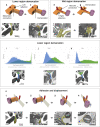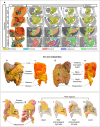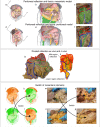The development and structure of the mesentery
- PMID: 34408242
- PMCID: PMC8373875
- DOI: 10.1038/s42003-021-02496-1
The development and structure of the mesentery
Abstract
The position of abdominal organs, and mechanisms by which these are centrally connected, are currently described in peritoneal terms. As part of the peritoneal model of abdominal anatomy, there are multiple mesenteries. Recent findings point to an alternative model in which digestive organs are connected to a single mesentery. Given that direct evidence of this is currently lacking, we investigated the development and shape of the entire mesentery. Here we confirm that, within the abdomen, there is one mesentery in which all abdominal digestive organs develop and remain connected to. We show that all abdominopelvic organs are organised into two, discrete anatomical domains, the mesenteric and non-mesenteric domain. A similar organisation occurs across a range of animal species. The findings clarify the anatomical foundation of the abdomen; at the foundation level, the abdomen comprises a visceral (i.e. mesenteric) and somatic (i.e. musculoskeletal) frame. The organisation at that level is a fundamental order that explains the positional anatomy of all abdominopelvic organs, vasculature and peritoneum. Collectively, the findings provide a novel start point from which to systemically characterise the abdomen and its contents.
© 2021. The Author(s).
Conflict of interest statement
The authors declare no competing interests.
Figures





References
-
- Coffey, J. C. & Dockery, P. Ch 62. Peritoneum, mesentery and peritoneal cavity. in Gray’s Anatomy: The Anatomical Basis of Clinical Practice(42nd edition) 1150–1160 (2020).
-
- Toldt C. Bau und Wachsthumsveränderungen der Gekröse des menschlichen Darmkanales. Denkschrdmathnaturwissensch. 1879;41:56.
MeSH terms
LinkOut - more resources
Full Text Sources
Research Materials

